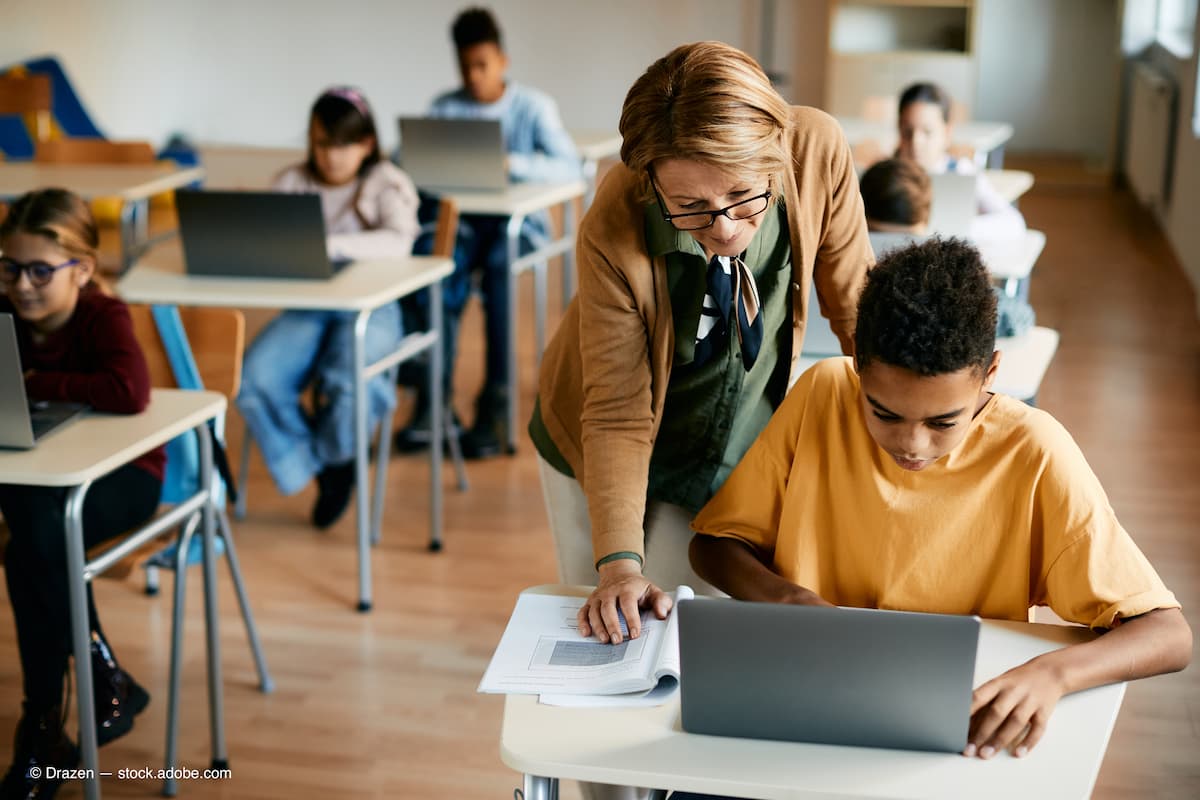AOA 2023: Virtual school: The long-term visual effects
Optometrists should be aware of the consequences of digital device use beyond myopia.
Reviewed by Glen Steele, OD, FAAO
The coronavirus pandemic changed the playing field for students by creating a new set of specified and sustained visual activities.
The use of electronic devices has provided children and adults with unparalleled access to useful information, but on the flip side, that 24/7 access is at the root of disrupted development and psychological issues. (Adobe Stock / Drazen)

The main focuses of student learning during the pandemic were computers and various devices, and this new normal continued despite the return to the classroom.
“Kids who were on the edge of having visual issues are now the most vulnerable when school went virtual for extended periods of time.” Glen Steele, OD, Professor Emeritus, Southern College of Optometry, Memphis, emphasized at the 2023 American Optometric Association annual meeting held in Washington, D.C.
“This increases our need to be aware of the consequences of device use—more than myopia. The areas of ocular motility, binocular function, and accommodation are significantly impacted. Our testing must be more in-depth and directed to these areas.”
The use of electronic devices has provided children and adults with unparalleled access to useful information, but on the flip side, that 24/7 access is at the root of disrupted development and psychological issues. These include depression and physical unhealthiness; a lack of motivation, imagination, and social skills; stunted motor skills; and addiction.
Regarding visual effects, Steele described video game syndrome characterized by asthenopia (headache, eyelid tic, transient diplopia, and dizziness), absence of fine stereopsis, and refractive errors in which these manifestations developed more frequently in the dominant eye in children in a study of the effects of video games.
Optometrist involvement
He advised that when examining children, optometrists observe the patterns of “look-attend-focus-identify-engage” exhibited by the patients and parents: what is happening when I walk into the room, what the children do when they are engaged in a scanning game as you come into the room, what it takes to get them to put the phone down, and what the parent is doing with their own phone during the examination and consultation.
Most children exhibiting these findings are aged 7 to 15 years, and Steele noted that “it is alarming to observe the rapid and persistent physical changes at these early ages.”
He also noted that among these patients, the visual complaints are vague and most often related to distance vision. Specifically, the ability to achieve sharp distance vision is difficult (20/25), the refraction is plano to +0.50 diopter, the responses to stereo testing are reduced to below 40 seconds, accommodation is significantly reduced including reduced visual acuity at near, and unresponsive in a test of accommodation during Just Look Retinoscopy, accommodative facility shows marked reduction (difficulty clearing, and at ± 2.00 diopters and most cannot clear at all).
Pupils are also affected in that they are very large. Steele cautioned that the pupillary enlargement is not an isolated feature.
“When pupils are atypical, they usually show moderate reaction to direct pupillary light, most often do not show a pupillary change to accommodation with Just Look Retinoscopy, and with moderate motion change the pupillary size does not change,” he explained.
This information is useful, Steele said. He advised optometrists to link their observations to the patient history and findings and become comfortable asking questions.
He described a small study of 27 patients aged 7 to 10 years with pupils that exceeded 7 mm. When the children were asked about video games, 26 of the 27 responded positively, which was confirmed by the parents.
“Because of these links, optometrists should be at the table when discussions of the impact of device use take place in all community, state, and national organizations. Start asking that question about device use,” Steele emphasized.
He also found that older teenagers and young adults generally do not have larger pupils because when they were younger, they were using hand-held devices and the monitor was a few feet away.
Steele explained that the pupillary enlargement results from fight, flight, or freeze responses that persist after stopping the game or other forms of scanning, a persistent sympathetic response. He expressed concern because this is being seen increasingly and theorized if the pupillary size is associated with a persistent sympathetic response, other body functions are potentially involved.
The other bodily functions involved in the activated fight or flight response are accelerated heart rate, widen bronchial passages, constricted blood vessels, decreased motility in the large intestine, increased esophageal peristalsis, piloerection and perspiration, and increased blood pressure.
Steele shared specific age-related recommendations. For asymptomatic pre-schoolers, a 5-second break every 5 minutes while looking away 5 feet; for schoolchildren, the times are extended to 10-10-10; for asymptomatic teens and adults, those times extend to 20-20-20.
In patients with a persistent sympathetic response who also exhibit a concurrent reduction in the accommodative response, optometrists can consider the use of low plus lenses for all near activities.
In those with an exaggerated persistent sympathetic response and little response to lenses, vision therapy should be considered in addition to the low plus lenses.
He concluded that parents should be educated about the harmful long-term effects of use of electronic devices and taught how to manage device use.
Reference
1. Rechichi C,De Mojà G, Aragona P. Video game vision syndrome: a new clinical picture in children? J Pediatr Ophthalmol Strabismus. 2017;54:346-55.
Newsletter
Want more insights like this? Subscribe to Optometry Times and get clinical pearls and practice tips delivered straight to your inbox.